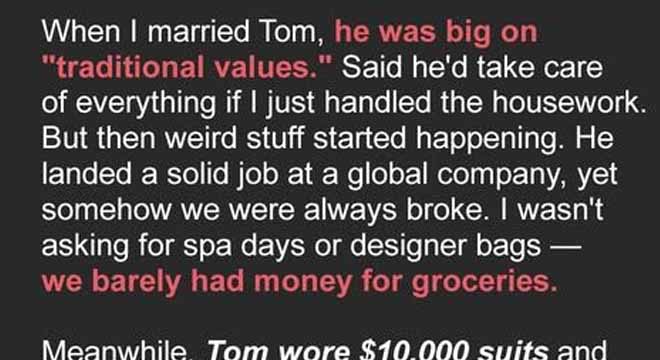When I married Tom, he was big on “traditional values.” The kind that sounded sweet at first—he’d take care of everything financially, and I’d handle the home. “You’ll never have to worry about a thing,” he told me with that charming grin. At the time, I thought I’d hit the jackpot. A man who wanted to protect and provide? Sounded like a dream.
But it didn’t take long for that dream to start cracking.
Tom landed a solid job at a global tech firm just a few months into our marriage. Great salary, bonuses, the whole package. Meanwhile, I kept the house spotless, cooked every meal, handled the bills, and even clipped coupons to stretch our grocery budget. I wasn’t asking for much—no spa days, no designer handbags. I just wanted to feel like we were stable.
Instead, we were always broke.
Every time I checked the account, we were scraping by. Our fridge was half-empty, I had to make thrift store clothes stretch, and our internet got cut off more than once for late payments. But somehow, Tom showed up in \$10,000 suits, designer shoes, and a new luxury watch every few months.
“Networking,” he’d say. “It’s part of the image.”
So why was I using coupons for canned soup while he played Mr. Important?
At first, I questioned myself. Maybe I was overspending. Maybe I didn’t understand how “expensive” life could be for a man in his position. But the numbers didn’t lie. His income was high, and our lifestyle was… well, mine wasn’t even middle-class.
Then came the excuses.
I suggested getting a part-time job to help out. Tom shut that down quickly. “Why would you want to work? It’s better for both of us if you focus on the home.” Translation: stay in your place.
But after nearly two years of constant stress and never-ending explanations about missing money, I stopped asking and applied for a remote job in secret. Within a month, I was bringing in a steady income.
And guess what?
The very next month, Tom announced he was taking a “voluntary pay cut” due to restructuring at work. Convenient, huh?
His new salary was nearly 20% lower—just enough to cancel out what I had started bringing in. Suddenly, every financial gain I made was offset. And when I questioned it, he got defensive.
“You think I *wanted* to take a pay cut? This is why I didn’t want you working. It’s distracting you from the home.”
Distracting? From what—boiling noodles while he drained our finances into his wardrobe and ego?
That’s when I started digging.
I went through statements, receipts, old emails—anything I could find. What I discovered made my blood run cold. Tom had opened credit cards in both our names, taken out a loan I never knew about, and had been funneling money into an account I wasn’t allowed to access.
Worse? He’d been making large purchases—jewelry, dinners, even hotel stays—that I couldn’t explain.
I confronted him. He gaslit, deflected, shouted. Told me I was crazy. But he saw it in my eyes—I wasn’t falling for it anymore.
The very next week, I opened a new account in my name only. Moved my paychecks. And then I filed for divorce.
Turns out, Tom wasn’t about “traditional values.” He was about control, manipulation, and living large while keeping me small.
I may have entered that marriage believing I was stepping into a partnership—but I left it knowing I had reclaimed my independence.
And these days? I wear what I want, eat what I like, and pay for everything myself—with money no one else touches.
Because tradition means nothing when it’s used as a cage.
